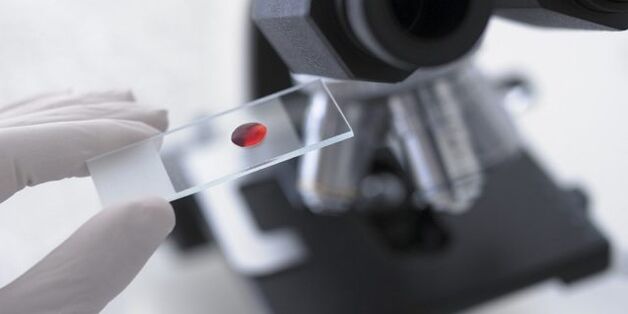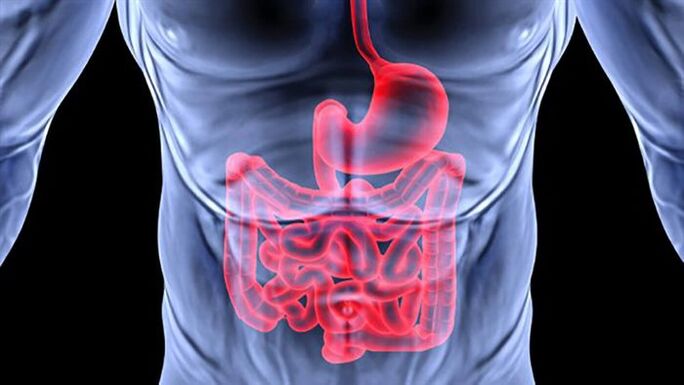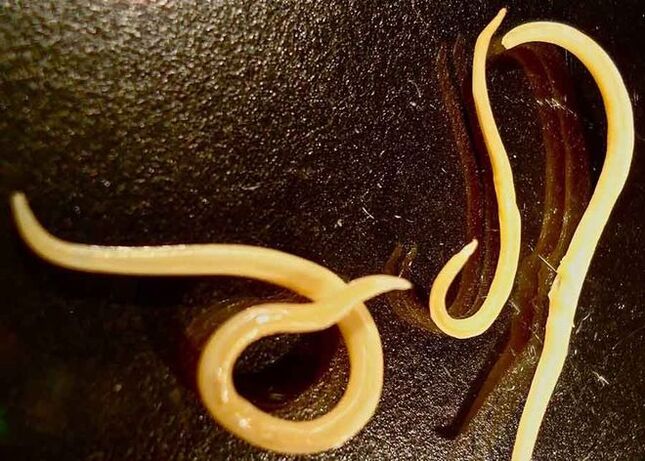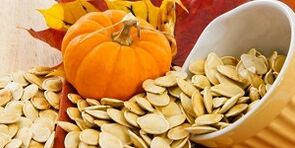Before starting treatment with parasites, it is important to determine exactly which type is present in the body.This is necessary to choose effective treatments as most medicines are created specifically to get rid of a specific type of helminth.The main diagnostic methods for determining the pathogen of invasion:

- Stool analysis;
- Blood test: general as well as immunosorbent;
- blur;
- Analysis of the secrets of the 12-sexual intestine;
- tomography;
- Ultrasound.
Parasites can be detected using a blood test.With one negative result, most of the tests should be redirected.This is necessary to achieve a reliable result.If the test results confirm the presence of a helminth invasion, it is important to start therapy against worms immediately.It provides 3 consecutive stages:
- The preparation of the body is the use of sorbents, pumpkin oil, which activates the process of excretion of accumulated toxins.It lasts 5-7 days.
- The use of anthelmintic drugs can be drops or suspensions designed to destroy a certain type of parasites:
- Nematodes will help wide medicines;
- The recovery stage - helps to restore the normal functioning of the body, the functioning of the immune system.It ensures the use of sorbents, vitamin complexes, in some cases other medicines are prescribed.
Helminthiasis treatment should be performed under the supervision of a doctor.When it comes to worms and plates infection, hospital therapy is shown.Pharmacological drugs are very toxic.After their use, there are strong side effects, their intake is strictly prohibited by pregnant women.In this regard, many prefer to get rid of worms with the help of traditional medicine.Its arsenal has many recipes whose effectiveness has been tested for centuries.A large number of herbs and plants have a pronounced effect against worms: pumpkin, tancy, wormwood, immortal, linen, onions, garlic, nuts, grenades, carrots.Based on the decoction, infusions are prepared.They are designed to receive oral or cleaning enemas.The latter are assigned to fight parasitic helminths in the intestine.When choosing a treatment method, note that the recipe does not contain components of the plants to which you are allergic.In order to minimize the risk of helminth infection, it is important to constantly monitor preventative measures:
- Wash your hands before eating and even after visiting the toilet, contact with animals;
- Wash fruits, vegetables, green thoroughly and carefully pour the boiling water;
- Provided sufficient meat from heat purification, fish;
- Perform pets.
To prevent parasites, always wash your hands well. With the first symptoms of helminthiasis, even if you may not be able to get infected with worms anywhere, you should see a doctor.He will prescribe diagnostics, if necessary, chooses a tool for worm therapy.
Are the worms the simplest
Sometimes you can hear the phrase that the patient is infected with the simplest worms.You need to understand that the simplest are extremely unicellular microorganisms, in extreme cases those that organize the colonies.But they are never very cellular, like worms and helminths.For protozoa, all processes are carried out in cell cytoplasm and cell nuclei, while the worms are much more complex: they have differentiated organs that perform special physiological functions.It is therefore wrong to consider the worms to the most root.Sometimes helminths are called the simplest parasites compared to insects: bugs, lice, etc., since the latter are much higher on the evolutionary ladder.In such an interpretation, the name of the worms is allowed.
The most common parasites
The most common in endoparasites include, of course, helminths (worms), which, according to various sources, are infected by more than 80% of the planet's population.A huge number of these parasites are divided into basic species:
- Nematodes - roundworms (ascaris, tweezers, trichinella, Vlasov, etc.);
- Cestodi - red worms (ribbons, pork and bull tapeworm, tapeworm, etc.);
- Trematodes-cellar workers (liver, blood, pulmonary, as well as plates living in the intestine).
Sometimes you can find a more general classification that all kinds of parasites of people are divided into:
- intestinal, parasitic in the intestine;
- tissue localized in other organs and tissues.

Consider a brief description of the most common types of helminths.
Roundworms (nematodes)
- Askarides - the most common roundworms with a length of 20 to 40 cm are parasitized in the small intestine, but pre -migrate in the human body affecting the blood and respiratory system.Along with the intestines, these parasites can be found in the liver and gallbladder, heart and lungs.The common symptom of ascariasis is an allergic reaction.
- Tips - small worms up to 1 cm affecting the intestines and leading to enterobiasis with a disorder of the gastrointestinal tract, exhaustion, sleep disorders, etc.A characteristic sign of the presence of pinch worms in the anus where they lay eggs.
- Trichinella - these microscopic worms (their size is only a few millimeters) lead to serious diseases - trichinosis, which can lead to death in the absence of treatment.Adult species live in the body of people in the muscles (breathing, face, etc.), causing muscle pain, fever, edema, allergic skin rashes.
- Vlasov - small worms (up to 4.5 cm long, with the front of the body in the form of threads), whose larvae cause trichozephalis with diarrhea, acute abdominal pain and other symptoms that resemble appendicitis.Due to the intoxication of the body, anemia develops.
Landworms (cestodi)
- A wide band, whose length of the body reaches 10 m, leads to the development of dipylobotriosis with nausea, weakness, vomiting, unstable stools, asthenia and anemia.
- The Sarski strip has a length of 3 to 8 m, parasitizes mainly in the small intestine and causes two diseases at a time: taeniosis with dyspeptic, astheno-neurotic and abdominal syndromes and cystimicosis with eBrites, intestinal, allergic and respiratory syndromes.Depending on the location of tsistitserki, muscles, brain, heart, eyes, etc.are affected.
- The bull chain, whose length can reach up to 18 m, causes tusarinchosis and is considered one of the most dangerous types of worms.If you do not do decontamination, it can live in the human body under 18-20 years old!It is located in the colon, causes severe intoxication with products of its vital activity, as well as diarrhea, nausea, vomiting, abdominal pain, anemia, allergic reactions and problems with the nervous system.
- The dwarf tank is only 1.5-5 cm a long source of hymenolepidosis with dyspeptic, pain and astheno-neurotic syndromes that suffer from the digestive and nervous systems of the body, as well as the liver.
- Echinococcus is considered to be the smallest tape tape - its length is only 2.5 to 8, rarely 9 mm, but infection with it has huge consequences in the form of liver and lung damage, where cysts and tumors are formed that cause dysfunction of these organs.
Tedious workers (trematodes)
- The liver solar or liver-water-water-shaped liver-shaped sheets with a length of 30-50 mm and 8-13 mm wide, there are suction glasses.It damages the liver membrane and, by clogging the bile ducts, is able to completely block the leakage of bile.This can lead to cirrhosis, jaundice and liver cancer.
- Foam (Siberian) plates or cat bickelter, flat coin 4-13 mm long.Localization - gallbladder, liver and pancreatic channels.It causes opistorchiasis with the development of gastritis, ulcers, pancreatitis, cholecystitis to liver cancer, which can lead to death.
- The pulmonary loss has an egg-shaped shape, a red-brown body with small spikes 7.5 to 12 mm long with a width of 4-8 mm.It affects the lungs, causing inflammation, exudative pleurisy, focal fibrosis and lung cancer.With the penetration of the brain, the causes of encephalitis and meningoencephalitis.
- Schistosomes (blood dishes) are separate worms with a size of 1-2 cm, whose eggs cause an enlargement of the liver, spleen and lymph nodes, the formation of polyps in the intestine, diarrhea, granulomatous inflammation leading to bladder cancer.
The simplest parasites
Toxoplasma (Toxoplazma gondii) - the type of parasites, the main owner is cats.They can also be transferred to warm -attached animals and humans.The disease caused by toxoplasm is called toxoplasmosis.The course of the disease is mild, except for the damage to the fetus inside the mother's womb, which creates serious consequences for both the mother and the fetus, even deadly.
Ameb is a simple unicellular organism that is considered one of the first beings living on Earth.The disease caused by Amoia is called amoebiasis.Intestinal infection, with predominant ulcerative damage to the colon with the appearance of bloody diarrhea, the possible formation of secondary intestinal foci, which tends to be a chronic course.Malarian plasmodium is the worst cell creature in the cycle of development, to which a person is a temporary host and the mosquito is constant.In the human body, the parasitic plasmodia is represented by 4 species:
- P.malarie - four -day malaria;
- P.Vivax - three -day malaria;
- P.ovale - three -day malaria Ovale;
- P.Falciparum - tropical malaria;
The duration of the interval between the outbursts depends on the type of pathogen.In addition to all this, anemia develops as plasmodium affects the blood cells of red blood cells. The disease can occur in both mild and severe form.
Paths of penetration into the body:
- Water - through dirty water;
- Contact - household - when using items, clothes, dishes;
- Alimentary - through dirty vegetables, fruits, products that have not undergone heat treatment.
Sometimes it happens that the parasite carrier does not become ill, but it is only a carrier and radiates the pathogen in the external environment.There are only a few cysts of lamblia in the development of the disease in the human body.Leishmania - Representatives of this kind are the cause of leishmaniosis.Mosquitoes are carriers.The main contingent of the lesions is people, rodents, mammals.The complete development of the pathogenic organism requires the presence of two owners.It is a mosquito and a representative of vertebrates.Human diseases caused by invasion of Leishmania:
- Visceral leishmaniasis (fever of thought)-there is a lesion of the internal organs;
- Skin leishmaniasis (Baghdad ulcer) - skin lesion, most often the head, followed by the formation of scars;
- Leishmaniosis of the skin and mucous membranes - manifests itself through severe destructive damage to the skin and mucous membranes
- Prevention consists in the renovation of mosquito reproduction outbreaks, the destruction of rodents, the control over the number of dogs, the funeral of the dead animals.
Trichomonads - flaglated unicellular organisms of pear shape, cause trichomonosis disease, transmits sexually and affects the geniopoline system.It is remarkable that men and women are sick, but in men the disease is usually asymptomatic.Tripanosomes - the genus of the unicellular protozoa flag.A serious disease of tripanosomosis is caused, sleep disease is deadly to humans.The Tripanos winner is Bugs, a Tseche fly.In the body of the host, the parasite spreads under the skin, then penetrates into the lymphatic system and blood.Most pathogens are in the spinal cord, where cells destroy and release their toxins.
Flat helminth
Mountain parasites or saucepes (trematodes) have a characteristic shape of body-shaped leaves.Their structure is quite organized - they have a digestive, excretory and nervous system.During the life cycle, they change their owners.The distribution has received the following types:
- Siberian bikars (cat bicoms) or opistorchis.Most often, the infection is performed by raw fish, which leads to a rather dangerous disease - ophorchiasis.The spread of parasites occurs very quickly, which can cause serious consequences.The worms have a yellowish shade and their length can exceed 12 m.Close up in the human body, these parasites provoke internal bleeding, disrupt bile flow, cause pancreatic dysfunction.Hazardous consequences: purulent Holagitis, Achilia, Holangocarcinoma.
- Liver bacon.The intermediate host is representatives of cattle, and a person is infected by eating poorly treated meat from affected animals.As a result of the infection, facioleosis develops.In size, these worms are relatively small (no more than 5-6 cm), but are able to provoke dangerous pathologies: liver abscesses, cholangitis, hepatitis.Through blood, parasite larvae can spread throughout the body.
- Schistosome.The worm is able to sit in the blood vessels by consuming blood components.As a result of your life, the development of varicose veins, tumor formations is possible.The main symptom is intense general intoxication.
Bull Taper
Bull Tapeworm can reach a length of up to 12 m.This is a hermaphrodite that can produce more than 100,000 eggs, they are withdrawn with excrement.Eggs fall into the soil, then these plants eat livestock on the plants.In the body of the animal, eggs become larvae that are localized in the muscles.If a person eats infected beef, the larvae fall into the intestine.The larvae are not transmitted from person to person.
Adult worms have a head with four suction glasses, neck and body consisting of segments.The number of segments is steadily increasing, mature segments can be separated from the worm and crawl from the intestine of the person.
Bull Taper: Symptoms
The symptoms of the disease are nausea, vomiting, dyspeptic disorders, increased salivation, dizziness, weakness, nervousness, fatigue, abdominal pain, allergies, appetite fluctuations.
To eliminate the scorching tapeworm from the body, there is a scheme consisting of 3 stages: preparatory (cleaning of the body), treatment with antiparasitic drugs, recovery (diet, herbal medicine).
Ribbon

Tape or cestodi type helminths include a variety of flatworms, the length of which can be from 2 mm to 10-12 m. The body of such parasites has specific structural segments, neck and head with suction cups (hooks) for fixing on the walls.The cestod is hermaphrodite and the eggs are located in segments.The worm is absorbed throughout the surface of the body.
Red worms
The following common types of ribbon worms are distinguished:
- Alveokkk.Its vital activity determines the appearance of an extremely dangerous disease - alveococcosis.People can have a length of over 4 m.The characteristic of these worms is the formation of the location of the dense nodes of a whitish hue with a diameter of more than 2 cm, which resembles a malignant tumor.The most characteristic localization is the lungs, kidneys and liver.They are able to provoke cholangitis and abscess, as well as spread to the spleen, muscles and brain.
- Tapes or solidaries.Such varieties as a bull and pork capes, a wide strip, are widely used.They differ in huge sizes - more than 10 m and a long life expectancy - more than 20 years.Bull Chain excites Shadowaline's disease and is generally found in the small intestine.Serious complications are cholecystitis, intestinal obstruction, appendicitis.The pork chain is slightly smaller than its "brothers" (2-3 m long).Causes Tussia.A wide band is manifested by such pathology as dipylobotriosis.The infection of them happens through poorly prepared fish.This worm is able to lead to the following consequences: intestinal atrophy, Gunter Glossia, Leukopenia.
Diseases that cause
The most dangerous parasites living in the human body can cause various diseases.Very often, the disease provoked by a particular parasite has the same name as it.So, different types of parasites in the human body can cause the following diseases:
- Some parasites in a person (plates) provoke trematodoses;
- Cestodosis occurs when the straps are damaged;
- If an adult or child in the intestine will have roundworms, then nematodoses are diagnosed;
- Drunks cause girudinosis;
- Adocephales provokes scraper.
However, more than one organ can affect the parasites in the human body.

- Eye damage;
- Diseases of the gastrointestinal tract that cause unicellular parasites and helminths, - ascaridosis, trichinosis, ankylostomosis, enterobiosis;
- Brain diseases - echinococcosis, toxoplasmosis;
- Dermatological diseases - demodicosis, pediculosis, scabies;
- Pathologies of the lungs - echinococcosis, ascaridosis, etc.;
- Liver disease - opishorchiasis, echinococcosis;
- In the mouth, in the area of the ears and oral cavity, parasites can cause different types of diseases;
- Heart pathologies;
- Diseases of the genius system;
- Pathologies of the blood vessels.
Medicines to treat parasitosis
A large amount of medicines have been developed to treat parasitosis at this time.For the treatment of helminthia, use wide action medicines and a narrow spectrum of action.In addition to these drugs, it is recommended to take vitamins, medicines to restore the intestinal microflora.Microflora and fermented dairy products from bacterial but not fungal acid dough contribute to recovery.Antihistamines and glucocorticoids are used to prevent strong allergic manifestations.In order to restore the digestive process, it is sometimes advisable to take digestive enzymes, choleric drugs.In the treatment of helminthiasis, it should be borne in mind that modern drugs significantly reduce the ability of helminths to withstand the digestive enzymes of the body, so it is not always possible to detect dead helminths in bowel movements.
Folk remedies
- Papaya: Papaya seeds are very useful for the treatment and withdrawal of intestinal worms.They have caricin, which is effective in killing roundworms.Add a teaspoon of powder seeds to a glass of water or milk and drink on an empty stomach in the morning, every day.
- Garlic: Very useful for home treatment of intestinal worms.Eat three garlic cloves every morning to achieve the best results.
- Carrots: Very useful for getting rid of hills on the tape.It is enough to take a few tablespoons of grated carrots in the morning on an empty stomach.
- Pumpkin: Take approximately one pumpkin dining room, peel with transparent flakes, cut and place in 250 ml of boiling water to make an infusion.And then drink it to drive the worms out of the gut
- Pomegranate: The bark, root and grenade stems are very effective for destroying worms
The most effective grenade bark is. The cold decoction of the bark at a dose of 90 to 180 ml should be drunk three times a day, at intervals for one hour.
- Turmeric: Dry powder or turmeric juice mixed with butter, milk or water is very useful not only for dehydration but also for bowel problems, especially chronic diarrhea.
- Birch leaves tincture on cognac.Fill the third part of the birch leaves, add cognac at the top and insist for three weeks.Then strain the tincture, mix in equal partitions with beets, carrots and honey, mix.Take three times a day for 100 g of the resulting mixture, 30 minutes before meals.
- Black poplar tincture.Take 40 drops of tincture 1 hour before meals 3 times a day for 20-30 days.
- Infusion of corn stigmas.Take 10 g of corn stigms, pour 200 g of hot boiled water, insist.Drink 1-2 tablespoons 3-4 times a day.
- Flax seeds powder and cloves of cloves.This tool is convenient in that it can be poured into dishes.
- Pear juice with flesh of fresh fruits, carrot juice is recommended for the treatment of children.Drink 50 ml at an idle time of the stomach before meals for a week, 10 days.
- Pumpkin seeds.You need to chew raw seeds on an empty stomach, along with thin green skin (it is precisely distinguished by powerful antigelmic properties).Daily part from 250 to 400 g of seeds, after which after a few hours it is necessary to drink a laxative tablet.The treatment period is from 3 to 5 days.
- Infusion of grinding fresh pomegranate bark.The PEEL 1 fruit mass is poured with boiling water (250 ml), insisted in the thermos for 1.5 hours.Filter.Dosage - on an empty stomach to drink every 4 hours before bedtime - laxative.
- For 300 ml of water, 3 tspCrushed raw materials.Boil on low heat for 15 minutes, insist 2 hours, LEDs.Norm per day: 30 ml 5 times.
- Infusion with and wormwood.3 tspIt is taken for 500 ml of water.Mixtures of powdered dried inflorescences (or fresh mass).Boil for 5 minutes, insist until cool.Filter.You should take no more than 50 ml at a time, in the morning, at noon, in the evening on an empty stomach for 5 days.
- Home triple.The collection in dry powder of equal parts of wormwood, spices and tancy is consumed for 1 tsp.4 times on an empty stomach during the day, chewing thoroughly, washed with clean water.
- Garlic.To clean the body of the parasites, you must eat on a hill every day in the morning and at night for a hill without salt and bread 2 to 4 teeth a week.
- Recipe for ancient delinquent miracle: Eat salt herring and big onion over the weekend.You can't eat and drink more until the evening.Helmints will climb the intestine with feces in the evening.

Parasites do not tolerate red pepper, sorrel, so it is necessary to include in the diet as often as possible.This is both treatment and prevention.In addition, in the treatment process it is necessary to exclude sweet, fatty foods from the daily menu.As well as oil, milk, butter products, canned foods and meats with smoked.It is important in this method of treatment to starve during the day and to empty the intestine by taking a plum compote.The next day you should drink three or four glasses of pumpkin seeds.
In the human body you can find a huge number of different parasitic worms that can be fixed in different internal organs.They all cause chronic diseases that can cause severe pathologies.If there are signs of helminthiasis of any type, you should consult a doctor to start adequate treatment.

















